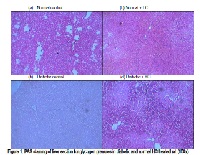Down Regulation of Plasma and Tissue Biomarkers by Homocastasterone
Keywords:
Homocastasterone, ketosteroid, plasma lipid, blood glucose, marker enzymeAbstract
Homocastasterone is a ketosteroid and a member of the brassinosteroid family of plant hormones. Earlier studies with 28-homobrasslinolide, an aldosteroid, had indicated that rat blood and tissue biochemical parameters studied were affected by this compound, resulting in altered homeostasis and cellular phosphorylation status, rendering this plant oxysterol inappropriate for high energy related work activities. The use of the ketosteroid in this study presents evidence for renormalization of elevated plasma lipid content in diabetic rat, antiglycemic potency, increase in liver glycogen and glucose level and diminished ALT and AST enzyme activities. A role for this ketosteroid in rat liver gluconeogenesis and in lipid homeostasis is suggested while the aldo and keto forms regulated glucose homeostasis in the rat. The observed differences in the effects of homobrasslinolide and homocastasterone as exogenous oxysterols on normal and diabetic rat plasma lipid level suggests the possibility of differential influence by endogenous aldo and keto oxycholesterol forms on glucose and lipid homeostasis in mammalian physiology.
References
Gruszka D. The brassinosteroid signaling pathway-new key players and interconnections with other signaling networks crucial for plant development and stress tolerance. Int J Mol Sci. 2013 Apr 24;14 (5):8740-74.
Davison GP, Restrepo R, Martínez G, Coll F, León OS. Effects of a brassinosteroid analogue to mosquito larvae. Ecotoxicol Environ Saf. 2003 Nov;56(3):419-24.
Verger Ph, Leblanc JC. Concentration of phytohormones in food and feed and their impact on the human exposure. Pure Appl Chem. 2003;75(11):1873–1880.
Vaya J, Szuchman A, Tavori H, Aluf Y. Oxysterols formation as a reflection of biochemical pathways: summary of in vitro and in vivo studies. Chem Phys Lipids. 2011 Sep;164(6):438-42.
Mohammadi A, Oshaghi EA. Effect of garlic on lipid profile and expression of LXR alpha in intestine and liver of hypercholesterolemic mice. J Diabetes Metab Disord. 2014 Jan 29;13(1):20.
Muthuraman P, Srikumar K. Induction of hexokinase I expression in normal and diabetic rats by a brassinosteroid isoform. Eur J Pharm Sci. 2010;41(1):1–9.
Muthuraman P, Srikumar K. A Plant Oxysterol as a regulator of glucose homeostasis. International Journal of Phytomedicine 2011: 2(2).
Nirmal Kumar G, Lakshmy S, K. Srikumar K. Negative modulation of alkaline phosphatase and creatine kinase by homobrassinolide. International Journal of Drug Delivery 2 (2010) 258-264.
Muthuraman P, Ravikumar S, Vikramathithan J, Nirmalkumar G, Srikumar K. Effect of phytohormones on tissue hexokinase and on some blood components in Wistar rats. Int J Drug Delivery. 2010;2:168–172.
Premalatha R, Jubendradass R, Rani SJ, Srikumar K, Mathur PP. A phytooxysterol, 28-homobrassinolide modulates rat testicular steroidogenesis in normal and diabetic rats. Reprod Sci. 2013 May;20(5):589-96.
Esposito D, Kizelsztein P, Komarnytsky S, Raskin I. Hypoglycemic effects of brassinosteroid in diet-induced obese mice. Am J Physiol Endocrinol Metab. 2012 Sep 1;303(5).
Lowry OH, Rosebrough NJ, Farr AL, Randall RJ. Protein measurement with the Folin phenol reagent. J Biol Chem 1951;193(1):265-75.
Van der vies J. Two methods for the determination of glycogen in liver. Biochem J 1954;57(3):410-6.
Hyvarinen A, Nikkila EA. Specific determination of blood glucose with o-toluidine. Clin Chim Acta. 1962;7:140-3.
Suvarna, S Kim. Layton, Christopher. Bancroft, John, D. Theory and practice of histological techniques. By S. Kim Suvarna, Christopher Layton, John D. Bancroft. Churchill Livingstone Elsevier (Oxford), England, 7th ed, pp.652, 2013.
Prakasam A, Sethupathy S, Pugalendi KV. Influence of Casearia esculenta root extract on protein metabolism and marker enzymes in streptozotocin-induced diabetic rats. Pol J Pharmacol 2004;56(5):587-93.
Ohaeri OC. Effect of garlic oil on the levels of various enzymes in the serum and tissue of streptozotocin diabetic rats. Biosci Rep 2001;21(1):19-24.
Esposito D, Komarnytsky S, Shapses S, Raskin I. Anabolic effect of plant brassinosteroid. FASEB J 2011; 25(10):3708-19.
Visweswara Rao P, Madhavi K, Dhananjaya Naidu M, Gan SH. Rhinacanthus nasutus Improves the Levels of Liver Carbohydrate, Protein, Glycogen, and Liver Markers in Streptozotocin-Induced Diabetic Rats. Evid Based Complement Alternat Med .2013;2013:102901.
Annida B, Stanely Mainzen Prince P. Supplementation of fenugreek leaves lower lipid profile in streptozotocin-induced diabetic rats. J Med Food 2004;7(2):153-6.
Pari L, Amarnath Satheesh M. Antidiabetic effect of Boerhavia diffusa: effect on serum and tissue lipids in experimental diabetes. J Med Food 2004;7(4):472-6.
Kaleem M, Medha P, Ahmed QU, Asif M, Bano B. Beneficial effects of Annona squamosa extract in streptozotocin-induced diabetic rats. Singapore Med J 2008;49(10):800-4.





